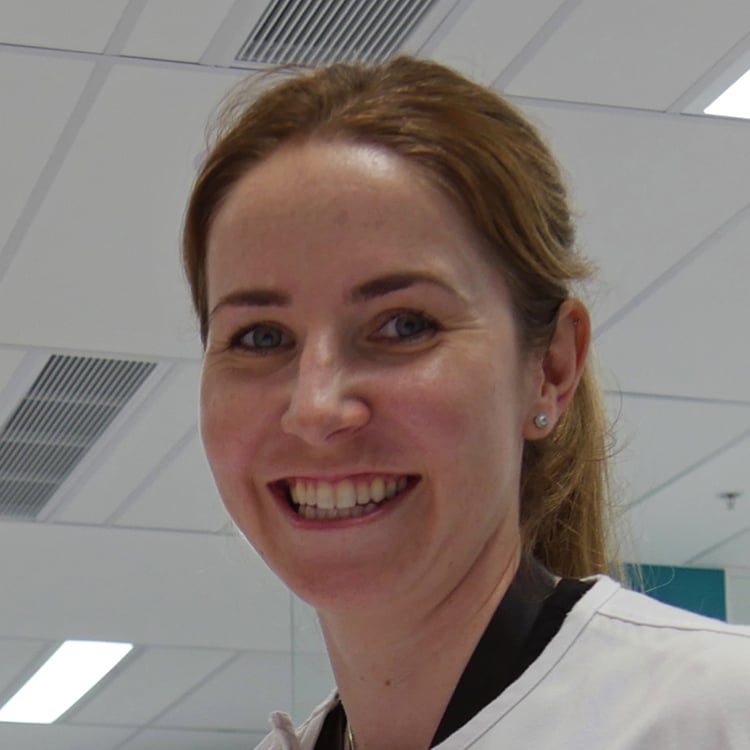
Stephanie Trend
Honorary Research Associate
BSc PhD
stephanie.trend@thekids.org.au
Stephanie Trend is a researcher with a focus on studying the immune system, who aims to help understand the causes of autoimmune conditions so that they can be better treated, and even prevented, in future.
Stephanie’s research focuses on people living with Multiple Sclerosis (MS). Dr Trend is currently leading Projects funded by competitive grants from MS Australia to investigate the role of antigen-specific B cells and neutrophils in the onset of MS using advanced single cell technologies.
Stephanie was awarded a PhD in the field of Immunology and a BSc with a double major in Microbiology and Pathology from the University of Western Australia. Stephanie was appointed the MSWA Research Fellow at the Perron Institute for Neurological and Translational Science in 2019.
Stephanie is a co-chair of the Kids Immunology Club, a member of The Kids early-mid career researcher (EMCR) council, as well as an active member of the Australian and New Zealand Society for Immunology and the Antibody Society.
Education and qualifications
- PhD – University of Western Australia
- BSc (Hons) – University of Western Australia
Active collaborations
- Biological roles of activated neutrophils in MS with A/Prof Anne Brüstle at the Australian National University
Projects
Investigating the role of Neutrophils in Multiple Sclerosis
Neutrophils are a type of immune cell that can trigger inflammation and may play a role in the development of MS.
Temporal dynamics of B cell dysfunction and EBV responses in early multiple sclerosis
Multiple sclerosis (MS) is an incurable condition where a person’s immune system mistakenly attacks their own brain and spinal cord.
What is triggering immune reactions in people with MS?
Multiple sclerosis (MS) is a condition where a person's immune system attacks the brain and spinal cord.
Developing a novel therapeutic pipeline for antibiotic resistant bacterial lung infection in children: investigating and assessing the potential phage therapy
Antimicrobial resistance is a global health crisis, which has accelerated due to the overuse of antibiotics.
UVB phototherapy for participants with an early form of multiple sclerosis
Published research
Proteomics confirms immune stabilizing effects of narrowband UVB treatment in patients with clinically isolated syndrome and multiple sclerosis
Multiple sclerosis (MS) demonstrates a latitude gradient in prevalence and severity, implicating ultraviolet B (UVB) exposure and photoimmune mechanisms in disease risk and progression. While narrowband (NB)-UVB phototherapy has long stabilized inflammation in dermatology, its systemic immunomodulatory effects in MS remain incompletely defined.
Assessing neutrophil subsets in autoimmune disease: Moving away from relying on density?
Neutrophils are the most abundant immune cell in circulation. However, due to a number of technical challenges for researchers, including the neutrophil's short lifespan and difficulties with preservation, they are often discarded during blood processing and thus ignored in cohort studies. As such, the contribution of neutrophils to disease and their involvement in disease mechanisms is less explored compared with other immune cell types.
Genome Sequence of a Lytic Staphylococcus aureus Bacteriophage Isolated from Breast Milk
We identified a double-stranded DNA (dsDNA) bacteriophage appearing to belong to Herelleviridae, genus Kayvirus. The bacteriophage, Biyabeda-mokiny 1, was isolated from breast milk using a clinical isolate of Staphylococcus aureus.
Epstein–Barr virus infection, B-cell dysfunction and other risk factors converge in gut-associated lymphoid tissue to drive the immunopathogenesis of multiple sclerosis: a hypothesis
Multiple sclerosis is associated with Epstein–Barr virus (EBV) infection, B-cell dysfunction, gut dysbiosis, and environmental and genetic risk factors, including female sex.
Sex-Specific Environmental Impacts on Initiation and Progression of Multiple Sclerosis
The immunological mechanisms that contribute to multiple sclerosis (MS) differ between males and females. Females are 2-3 times more likely to develop MS compared to males, however the reason for this discrepancy is unknown. Once MS is established, there is a more inflammatory yet milder form of disease in females whereas males generally suffer from more severe disease and faster progression, neural degradation, and disability.
Changes in serum neurofilament light chain levels following narrowband ultraviolet B phototherapy in clinically isolated syndrome
To determine whether serum neurofilament light chain (sNfL) levels are suppressed in patients with the clinically isolated syndrome (CIS) following narrowband ultraviolet B phototherapy (UVB-PT).
FcgammaRIIb Expression Is Decreased on Naive and Marginal Zone-Like B Cells From Females With Multiple Sclerosis
B cells are critical to the development of multiple sclerosis (MS), but the mechanisms by which they contribute to the disease are poorly defined. We hypothesised that the expression of CD32b (FcγRIIb), a receptor for the Fc region of IgG with inhibitory activities in B cells, is lower on B cell subsets from people with clinically isolated syndrome (CIS) or MS. CD32b expression was highest on post-naive IgM+ B cell subsets in healthy controls. For females with MS or CIS, significantly lower CD32b expression was identified on IgM+ B cell subsets, including naive and IgMhi MZ-like B cells, when compared with control females. Lower CD32b expression on these B cell subsets was associated with detectable anti-Epstein Barr Virus viral capsid antigen IgM antibodies, and higher serum levels of B cell activating factor. To investigate the effects of lower CD32b expression, B cells were polyclonally activated in the presence of IgG immune complexes, with or without a CD32b blocking antibody, and the expression of TNF and IL-10 in B cell subsets was assessed.
Lactoferrin Expression Is Not Associated with Late-Onset Sepsis in Very Preterm Infants
Preterm infants are at a high risk of developing late-onset sepsis (LOS). Lactoferrin is one of the most abundant endogenous antimicrobial proteins expressed in breast milk, stools, and blood, and a candidate for preventive intervention. Large clinical trials have recently investigated whether enteral supplementation with bovine lactoferrin reduces LOS.
Narrowband UVB phototherapy reduces TNF production by B-cell subsets stimulated via TLR7 from individuals with early multiple sclerosis
At the end of a 60-day course of narrowband UVB phototherapy, administered to individuals with early multiple sclerosis, there were changes in the relative proportions of circulating B-cell subsets. This study investigated phototherapy-associated changes to cytokine responses of B cells when exposed to a TLR7 ligand.
